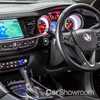General Motors has announced that the bulk of the cars sold under their brands - such as Chevrolet, Buick, Cadillac, GMC, Holden - will be adopting a common (and group-wide) software platform to run its in-vehicle systems and infotainment based on Android.
It’s not known just how much modification has been done to the vanilla version of Google’s mobile operating system, but the open-source nature, technological modernity, and wide developer support endows it with a huge advantage over competing alternatives.
Other automakers have opted to instead create their own software experience, sometimes from scratch but more often than not being a rather encompassing stack of software and user interface laid atop an existing platform such as Linux or QNX. This is, naturally, quite a costly endeavour by comparison.
Listening to customer feedback, General Motors are also working with Google directly to integrate Google Assistant to provide easy hands-free access to its voice assistant functions, but embedding it so that it pertains to certain convenience needs while driving such as embedded navigation.
We can see in these screenshots that not only is Google Maps preinstalled, but users will also have access to the Google Play Store, conceivably opening up the ability to install any number of full-featured apps if internet access permits. More like, though, GM will have a curated list of compatible apps that will be installable.
“We are re-envisioning the future in-vehicle customer experience, and this is just the first step. The integration of select Google technology and services into our vehicle infotainment systems will foster a more connected and efficient driving experience,” said Santiago Chamorro, vice president for Global Connected Customer Experience, GM.
“We will continue to offer our own unique infotainment features that only GM can deliver, such as service recommendations, vehicle health status, in-vehicle commerce and more, with the Google applications and services complementing our offerings.”
The American automaker said the new in-vehicle system will be rolling out to vehicles in select regions around the world beginning in 2021 with more broad deployment across all GM vehicle brands in the coming years. Expectedly, this includes the Australian market and Holden.


























